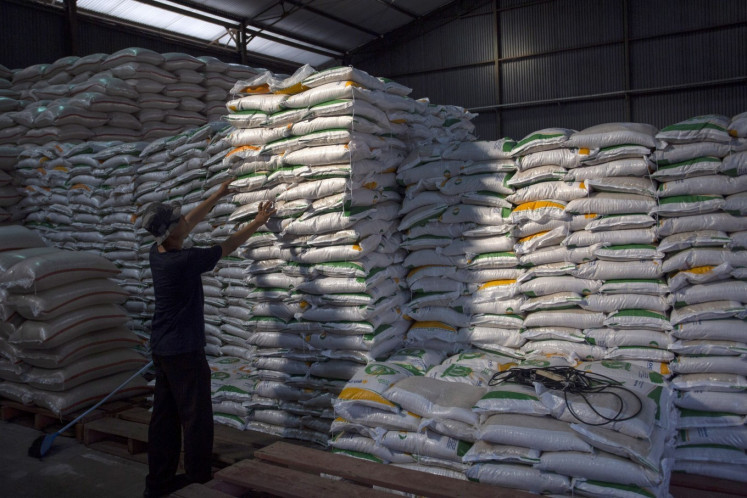Popular Reads
Top Results
Can't find what you're looking for?
View all search resultsPopular Reads
Top Results
Can't find what you're looking for?
View all search resultsWitness the richness of Indonesia through cultural events
It’s all here
Change text size
Gift Premium Articles
to Anyone
I
t’s all here. The unique culture, the rich natural resources and the diversity of its ethnic groups have attracted foreign tourists to Indonesia, and are waiting for Indonesians themselves to explore more of the archipelago.
And every day from January through December, cultural and arts festivals take place in many parts of the country.
Among those festivals and ceremonies, some still sound strange to our ears.
“Indonesia has 480 ethnic groups who speak 583 different languages. And many of the festivals, rituals and cultural performances are an inseparable part of the Indonesian people,” the Culture and Tourism Minister Jero Wacik said.
According to the book of events from the Culture and Tourism Ministry, in January alone, dozen of festivals are taking place and some traditional ceremonies are also worth witnessing.
Sikok Selawang ritual in Irat Village, Bangka Belitung, for example. The annual ceremony is usually held at the end of the harvesting period. The century-old ritual aims to show gratitude to the Almighty for the rice crop they get and wish for the abundance result in the next harvest.
People celebrate by gathering at the village hall and have a feast while chanting the verses of Koran.
On Feb. 12 in Nganjuk, East Java, people take part in the ritual bathing ceremony at the Sedudo waterfalls that is believed to bring health and eternal youth. The ceremony dates back to the time of Majapahit Kingdom in the 14th century.
The procession is led by the regent and is highlighted by a dance performance accompanied by the sacred Javanese songs (Sekar Mijil).
Still in February, dubbed as the most exciting ritual from West Sumba in East Nusa Tenggara, the Pasola jousting ceremony sees hundreds of horse riders who battle with each other with bamboo spears.
The ceremony starts with the arrival of sea worms, called Nyale, on the beach that people believe as a sign of rice crops. The fat worms mean a plentiful crop, but if the worms are thin, it will mean famine for the region. Pasola jousting runs through March.
Some ceremonies are also held to celebrate a religious day.
To celebrate Nyepi, also known as the Day of Silence, thousands of Hindu adherents flock to Amarta Jati Temple on Balekambang Beach in Malang, East Java, to attend Melasti, a ritual aimed at purifying the body and soul.
Another similar religious ceremony is held during Waisak Day when people from all over Indonesia and abroad gather at Borobudur Temple. Prior to the day, Buddhist priests take sacred water from Umbil Jumprit village in Temanggung, Central Java, and a flame called the fire of nature from a natural source in the Central Java town of Grobogan.
They put the water and the flame in the Mendut temple before taking the elements on a 5-kilometer procession to the Borobudur Temple for the final ceremony. In Kapuas Regency, Central Kalimantan, the people of Dayak Hindu Kaharingan organize the Tiwah ceremony in February, June and July. Tiwah is the final funeral ritual to honor the soul of the dead heading to the other world.
During the ceremony, people sing and dance with the remains of the dead. The peak of the ceremony is the slaughtering of a buffalo or more as sacrifice.
The Tiwah ceremony is usually held a year after the death, but most people decide to do it collectively as the ceremony requires a lot of money.
Such religious rituals have become special attractions for tourists. Some even spend the night watching the whole rituals.
Indonesia is a country that is full of myth. A story about Nyi Roro Kidul, who many Javanese believe was the ruler of the South Sea, is one of the famous yarns.
On Aug. 25 at Parangkusumo Beach, Yogyakarta is where the Labuhan ceremony takes place. Held to celebrate the Sultan of Yogyakarta’s birthday, people give offerings to Nyi Roro Kidul.
Similar rituals are also held on the same day at Mount Merapi and Mount Lawu.
As an archipelagic country, it is very common to see in many parts of Indonesia marine festivals, such as Bunaken Festival, Banda Festival and Togean Marine Festival.
In addition to that, some festivals are also arranged to demonstrate the richness and charm of our traditional performances. We can see the Traditional Dance Parade in Batam in March, Legu Gam in Ternate, North Maluku, and the Yogyakarta Art Festival.
There are also festivals held throughout the year. The first ones are the Wayang Orang and Ketoprak performances at the Jakarta Arts Building, followed by the Ramayana Ballet at the Prambanan Temple complex in Yogyakarta. There is also the Temple Festival in Bali and the Toraja Funeral Feast in Tana Toraja, South Sulawesi.
Events held this year are expected to attract 7.7 million foreign tourists, up from around 7 million in 2010. Tourists from Singapore, Malaysia, Australia, China and Japan dominated the total tourists visiting Indonesia last year.










